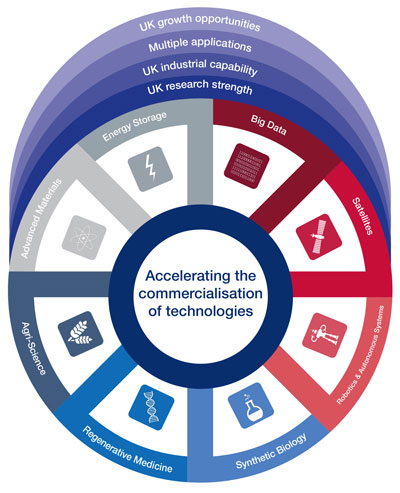2.1 Eight great technologies
In broader scientific terms, the government, with advice from the Research Councils, Innovate UK and the Government Office for Science, has identified, and announced financial support for eight emerging technologies as shown in Figure 3. The identified technologies are exciting, high-potential areas of STEM, mainly at an early stage in their growth.
- Big data and energy-efficient computing
As discussed in Section 1, the technology sector requires the development of new methods of handling data. Data is being generated at a growing rate, with 90 per cent of the world’s data being generated in the last two years. As well as making use of the data, work is also needed to minimise the computing power and memory needed for this data.
- Satellites and commercial applications of space
Satellites are a vast source of data, both in terms of space and Earth surveillance. Use of satellites for communications and broadcasting will continue to grow. In terms of employers, Airbus and Thales are the main companies involved in the construction of satellite platforms.
- Robotics and autonomous systems
Robotics now contributes strongly within agile manufacturing, logistics, medicine, healthcare, and commercial and consumer market segments. Using swarms of individually ‘stupid’ robots to complete extensive or complex tasks will become increasingly commonplace: for example, Coralbots were developed by Heriot-Watt University to assist with coral reef restoration and other threats to marine life. Markets for care robots and entertainment robots will also grow in importance.
- Synthetic biology
This field is ‘the convergence of IT and biological sciences to engineer genes to heal us, feed us and fuel us’ (Willetts, 2013). Potentially, it is a vast field of research with many start-up companies.
- Regenerative medicine and tissue engineering
This field covers the development of biological substitutes that can restore and maintain normal function with a very wide range of applications. It is currently focused on centres of medical research excellence.
- Agri-science
The increased application of science to agriculture is becoming more and more urgent in order to address the impact of climate change and desertification and an increasing world population.
- Advanced materials and nano-technology
The design of new and advanced materials – for example, nano-particles, graphene and quantum photonics – are all leading-edge applications that are close to being commercialised.
- Energy and its storage
Renewable energy and nuclear power have been a strong focus for the energy generation industry for some time. The 2015 Paris Climate Change Conference (Climate Action, 2015) has emphasised the size of the task ahead. As well as wind, solar and wave energy sources, plans for new nuclear power stations are likely to offer employment opportunities. Another growth area is power storage for renewable energy, including the UK National Grid, as well as new commercial applications (particularly cars and other vehicles).

